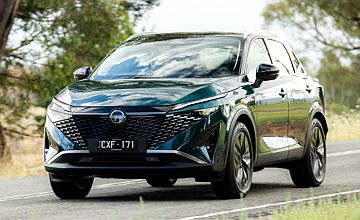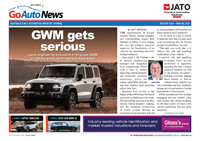OptionsCar reviews - Nissan - QashqaiNissan modelsOverviewWe like Even quieter cabin than before, outstanding fit and finish, eager performance of e-Power driveline, best warranty in the business Room for improvement Premium unleaded petrol required, 20-inch wheel/tyre combo a tad firm, second-row legroom borders on tight, e-Power models are pricey Quieter, better connected Qashqai range takes the fight to its Small SUV segment rivals17 Feb 2025 By MATT BROGAN Overview
NISSAN has introduced its refreshed Qashqai SUV range to local showrooms this week, the MY25 update seeing a considerable change in styling and connectivity.
Priced from $34,665 plus on-road costs – and with an introductory price of $32,665 until April 30 – the Hyundai Kona and Toyota Corolla Cross rival brings no change to the model’s tried and tested mechanical package.
Importantly, the grade walk for the MY25 Nissan Qashqai now more closely resembles that of the larger X-Trail: The entry ST grade is unchanged, but the ST+ becomes the ST-L, the ST-L the Ti, and the Ti the Ti-L.
The range is topped by the addition of the stylish N-Design e-Power, one of two petrol-electric grades offered across the Qashqai range.
The N-Design grade is characterised by body-coloured sill and wheel arche trims, 20-inch alloy wheels, gloss black wing mirror scalps, and blackened roof rails.
Those changes join broader updates including a striking three-dimensional grille, new LED headlights and DRLs, Super Red tail-lights with clear lenses, and a bevy of grade-specific alloy wheels ranging from 17- to 20 inches in diameter.
Three new paint colours join the Qashqai palette: Pearl White, Black Onyx, and Deep Ocean. A black-painted roof is available on Ti grades and above.
Moving inside, Nissan says the Qashqai’s cabin has been “enhanced to deliver an upscale ambience” with new patterned finishes adorning the centre control and decorative insert between the upper dashboard and glovebox.
On higher trim grades we find the application of Alcantara inserts on the dashboard, door card inlays, door armrests, centre console lid, and front-seat knee pads.
Upholstery is likewise refreshed with the N-Design grade adopting Alcantara and synthetic leather combination seating material.
Nissan now offers the Qashqai range with ambient LED lighting on Ti grades and above and a larger 12.3-inch infotainment touchscreen with wireless Apple CarPlay and Android Auto connectivity for all variants.
Further, connected car services and the Nissan Connect app give owners “instant access to their vehicle, with the ability to access key health and status information, trip history and any vehicle disturbances, including theft and tow alert” via their mobile phone.
Under the bonnet, the 2025 Nissan Qashqai retains the former model’s choice of a 110kW/250Nm 1.3-litre four-cylinder turbocharged petrol engine and continuously variable transmission or petrol-electric e-Power unit comprising 1.5-litre three-cylinder turbocharged petrol engine with power generator, inverter and electric motor. Total system power for the latter is 140kW/330Nm.
Nissan offers the Qashqai range with a 10-year/300,000km warranty including roadside assistance and flat price servicing bundle. Service intervals are set at 12 months or 15,000km (whichever comes first) and priced at $399 per visit.
Driving Impressions
We’ve covered the complex workings of Nissan’s e-Power range in detail before, so we’ll spare you the details, if you don’t mind; remembering of course there is no change to the petrol or petrol-electric drivelines of the new Qashqai, its chassis, proportions, or price.
The MY25 makeover is all about styling and technology, as covered above. Which means in a nutshell that the Qashqai is no different to drive … well, at least that’s the theory.
In practice, it’s an improved version of its former self – a handsome and well-finished five-seat Small segment SUV that deserves to sell far better than it does in our humble opinion.
Why? Well, for starters, the Qashqai is a beautifully finished contender that shames nearly all its Japanese compatriots, excluding perhaps the Honda HR-V.
It is also impressively quiet, aided by increased noise suppression materials in the firewall and clever noise cancelling technology, and deftly agile in a way that doesn’t compromise ride.
That said, the 20-inch wheel and tyre combo can be a little firm on unbroken surfaces.
Equipment inclusions are generous and safety above par. At the time of testing in 2022 (remembering the MY25 Qashqai is a facelift and not an all-new model), the Qashqai scored one of ANCAP’s best results on record for child occupant protection and safety assistance technology. ISOFIX and top-tether child seat restraints are standard on all grades.
Moreover, that safety technology isn’t overly bothersome or intrusive. On an extended drive program through Melbourne’s northern suburbs and picturesque Yarra Valley, the Qashqai’s ADAS tech performed exceptionally well, confused only by poor lane markings and crumbling road edges that would challenge even the best in market.
The Qashqai’s connectivity and infotainment tech is pretty easy to use too, although the newly introduced connected car services are a little old hat. With limited functionality when compared with others in the segment it remains useful but is not as feature rich as we would have liked. Still, kudos to Nissan for offering it here without jacking up the price.
We found the Qashqai familiar and comfortable, the front seats generously proportioned for a Small SUV segment car, and with both friendly ergonomics and decent outward vision. Supportive seats offer a level of refinement to a package that seems bigger in the front and cargo area than in the rear – though if rear legroom is an issue, there’s always the X-Trail for not much more money.
Cargo space is interesting in that it reduces incrementally in higher trim grades. Qashqai ST and ST-L offer 504 litres with the 60:40 rear seats in place, Ti and Ti-L petrol variants 479 litres, and Ti-L and N-Design e-Power variants 452 and 404 litres respectively. Still, it is far more generous than the likes of the Toyota Corolla Cross (380 litres) or Hyundai Kona (407 litres).
The battery of the e-Power duo accounts for some of the difference in cargo capacity, though it is worth remembering these variants do not come with a spare wheel. All told, cargo space ranges from 1328 to 1447 litres, while braked towing capacity jumps dramatically from 750kg in e-Power models to a more useful 1500kg in petrol grades.
A turning circle of 11.1m isn’t as tight as some of the Qashqai’s rivals, but is complemented by sweetly weighted and responsive steering, and in higher grades semi-autonomous parking assistance.
We found the performance of the petrol Qashqai both linear and responsive, but not nearly as impressive as the e-Power grades. The additional 30kW and 80Nm really gives the Qashqai e-Power some sparkle on the open road, effortlessly returning to the 100km/h limit after slowing for townships and tackling hills without raising a sweat.
The front-driven layout is calm and does not tug at the ‘wheel (torque steer) in the way some of the Qashqai’s lesser rivals can. The car’s dynamics are accurate and well acquitted, the body control exceptional for a vehicle that does not claim to be “sporty”. While the ride can feel a touch firm, it still delivers a comfortable ride we think very few would consider harsh.
On the fuel economy front – and noting the Qashqai’s need for 95RON or higher premium unleaded, we were impressed to find the consumption reality lived up to the claim. Nissan quotes a 6.1 litre per 100km Combined cycle usage rate for ST and ST-L grades, 5.8L/100km in high-grade ICE grades, and 4.8L/100km for e-Power grades.
On test, we achieved high six-litre figures in the petrol Ti-L and low five-litre numbers in the N-Design e-Power. With the Qashqai’s 55-litre fuel tank, that should return petrol owners a driving range of around 785km and petrol-electric owners 1050km – a pity then the e-Power Qashqai duo is so much dearer than its closest rivals…
Even so, we really enjoy driving the Qashqai and remain impressed by its refinement and ‘premiumness’.
In that respect, it is a vehicle that is a far closer match to the likes of the Honda HR-V and Renault Arkana than it is a Hyundai Kona or Toyota Corolla Cross, which Nissan tells us reflects the preferences of most Qashqai buyers (who seem to prefer the highest grades almost exclusively).
Whether that continues in a toughening economic climate remains to be seen, but if you have the coin, we think you could certainly do far worse. In our view, the Qashqai is a ripper little car that deserves to sell far better than it does.
Perhaps the new-look and added tech will help it find its potential.
 Read more10th of February 2025  UPDATE: Nissan-Honda merger unravellingJapanese media suggests Nissan is weighing its options as Honda MOU unravels7th of February 2025  New Navara, Patrol here by 2027: NissanImportant range updates, including Navara, Patrol, in Australian showrooms within 24 months6th of February 2025  Top heavy moves for Nissan AustraliaNissan leaves lower priced models to Chinese entrants as Aussie buyers chase higher spec6th of February 2025  Nissan warranty reinforces permanence in OzLocal MD says 10yr warranty underscores Nissan’s commitment to Australian customers4th of February 2025  Mitsubishi yet to decide on Nissan-Honda dealDecision on whether Mitsubishi joins planned Honda-Nissan merger pushed out to mid-Feb |
OptionsClick to share
|
















Facebook Twitter Instagram